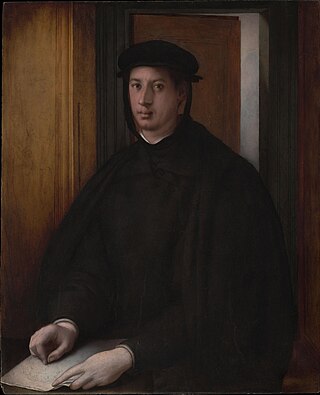
The House of Orsini is an Italian noble family that was one of the most influential princely families in medieval Italy and Renaissance Rome. Members of the Orsini family include five popes: Stephen II (752–757), Paul I (757–767), Celestine III (1191–1198), Nicholas III (1277–1280), and Benedict XIII (1724–1730). The family also included 34 cardinals, numerous condottieri, and other significant political and religious figures. The Orsini are part of the Black nobility who were Roman aristocratic families who supported the Popes in the governance of the Papal States.

The House of Sforza was a ruling family of Renaissance Italy, based in Milan. Sforza rule began with the family's acquisition of the Duchy of Milan following the extinction of the Visconti family in the mid-15th century and ended with the death of the last member of the family's main branch, Francesco II Sforza, in 1535.

Pope Leo XI, born Alessandro di Ottaviano de' Medici, was head of the Catholic Church and ruler of the Papal States from 1 April 1605 to his death, on 27 April 1605. His pontificate is one of the briefest in history, having lasted under a month. He was from the prominent House of Medici originating from Florence. Medici's mother opposed his entering the priesthood and sought to prevent it by having him given secular honours, but after her death he eventually was ordained a priest in 1567. In his career he served as Florence's ambassador to the pope, Bishop of Pistoia, Archbishop of Florence, Papal legate to France, and as the cardinal Prefect for the Congregation of Bishops and Regulars. He was elected to the papacy in the March 1605 papal conclave when he was almost seventy. He almost immediately suffered from fever and served as pope for 27 days.

The House of Medici was an Italian banking family and political dynasty that first consolidated power in the Republic of Florence under Cosimo de' Medici and his grandson Lorenzo "the Magnificent" during the first half of the 15th century. The family originated in the Mugello region of Tuscany, and prospered gradually in trade until it was able to fund the Medici Bank. This bank was the largest in Europe in the 1400s and facilitated the Medicis' rise to political power in Florence, although they officially remained citizens rather than monarchs until the 16th century.

Cosimo I de' Medici was the second and last duke of Florence from 1537 until 1569, when he became the first grand duke of Tuscany, a title he held until his death. Cosimo I succeeded his cousin to the duchy. He built the Uffizi (office) to organize his administration, and conquered Siena to consolidate Florence's rule in Tuscany. He expanded the Pitti Palace and most of the Boboli Gardens were also laid out during his reign.

Alessandro de' Medici, nicknamed "il Moro" due to his dark complexion, Duke of Penne and the first Duke of the Florentine Republic, was ruler of Florence from 1530 to his death in 1537. The first Medici to rule Florence as a hereditary monarch, Alessandro was also the last Medici from the senior line of the family to lead the city. His assassination at the hands of distant cousin Lorenzaccio caused the title of Duke to pass to Cosimo I de Medici, from the family's junior branch.

Giulia Romola di Alessandro de' Medici was the illegitimate, possibly multiracial, daughter of Alessandro de' Medici, Duke of Florence and his mistress Taddea Malaspina.

Virginia de' Medici was an Italian princess, a member of the House of Medici and by marriage Duchess of Modena and Reggio.

The Duchy of Urbino was an independent duchy in early modern central Italy, corresponding to the northern half of the modern region of Marche. It was directly annexed by the Papal States in 1631.

Paolo Giordano Orsini was an Italian nobleman, and the first duke of Bracciano from 1560. He was a member of the Roman family of the Orsini.

Adriana Basile was an Italian composer and singer of the Baroque period.

Ottaviano de' Medici was an Italian politician. He was the ancestor of the Princes of Ottajano line of the Medici family.

Taddea Malaspina was an Italian noblewoman of the 16th century. A scion of the Massa branch of the ancient Malaspina family, she was the mistress of Alessandro de' Medici, Duke of Florence, from the early 1530s to about 1537 and was likely the mother of at least two of his children, Giulio and Giulia de' Medici. Giulio de' Medici was associated with the Malaspina family at different points throughout his life.

Maria Salviati was a Florentine noblewoman, the daughter of Lucrezia di Lorenzo de' Medici and Jacopo Salviati. She married Giovanni delle Bande Nere and was the mother of Cosimo I de Medici. Her husband died 30 November 1526, leaving her a widow at the age of 27. Salviati never remarried; after her husband's death she adopted the somber garb of a novice, which is how she is remembered today as numerous late portraits show her attired in black and white.

The Princes of Ottajano are a cadet branch of the ducal dynasty of Tuscany. Along with the Veronese Medici Counts of Caprara, and Gavardo, they make up the last and closest descendants to the main line of the House of Medici.

Bindo Altoviti of the Altoviti family was an Italian banker and one of the most influential papal bankers of his generation. A patron of the arts, he cultivated close friendships with artists such as Benvenuto Cellini, Raphael, Michelangelo and Giorgio Vasari.
Alessandro de' Medici, 2nd Lord of Ottajano, was an Italian patrician, belonging to Neapolitan branch of House of Medici.
Giuseppe de 'Medici of Ottajano, Prince of Ottajano was an Italian noble and Sicilian politician from Naples.

Giulia da Varano, also known after her marriage as Giulia da Varano della Rovere, was an Italian noblewoman and member of the Da Varano family. She was the ruling Duchess of Camerino during 1527–1539 and by marriage Duchess of Urbino from 1534 until her death.

Vittoria Farnese, also known as Vittoria, Princess of Parma, and by her married name Vittoria Farnese della Rovere, was an Italian noblewoman, Duchess consort of Urbino from 1548 until 1574 by marriage to Guidobaldo II della Rovere, Duke of Urbino.
















